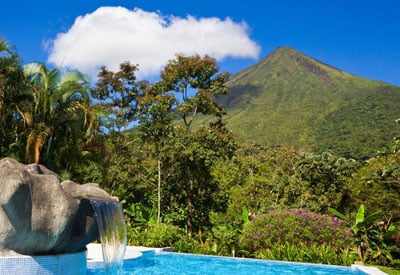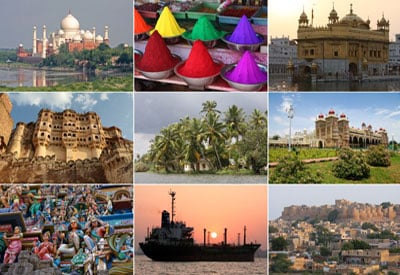The Republic of Costa Rica is a country in Central America, bordered by Nicaragua to the north, Panama to the east and south, the Pacific Ocean to the west and south and the Caribbean Sea to the east.
Costa Rica is the only Latin American country included in the list of the world’s 22 older democracies. Costa Rica has consistently been among the top Latin American countries in the Human Development Index, ranked 62nd in the world in 2010, and is cited by the UNDP as one of the countries that has attained much higher human development than other countries at the same income levels. The country is ranked 3rd in the world, and 1st among the Americas, in terms of the 2010 Environmental Performance Index.
With a $2.2 billion per year tourism industry, Costa Rica is the most visited nation in the Central American region, with two million foreign visitors in 2008. Since 1999, tourism earns more foreign exchange than the combined exports of the country’s three main cash crops: bananas, pineapples and coffee.
In this Country Profile
Coffee production has played a key role in Costa Rica’s history and economy and by 2006 was the third cash crop export. The largest coffee growing areas are in the provinces of San José, Alajuela, Heredia, Puntarenas, and Cartago. Costa Rica is famous for its gourmet coffee beans, with Costa Rican Tarrazú among the finest Arabica coffee beans in the world used for making espresso coffee, together with Jamaican Blue Mountain, Guatemalan Antigua and Ethiopian Sidamo.
In recent times pharmaceuticals, financial outsourcing, software development, and ecotourism have become the prime industries in Costa Rica’s economy. High levels of education among its residents make the country an attractive investing location.
Professional Spanish translation and interpreting services are crucial to any foreign companies and individuals with business interests in Costa Rica. We can gladly provide you with the finest and most accurate Spanish language translations to help you in your job or your business. We aim to have you absolutely satisfied!
:: Background of Costa Rica ::
Although explored by the Spanish early in the 16th century, initial attempts at colonizing Costa Rica proved unsuccessful due to a combination of factors, including: disease from mosquito-infested swamps, brutal heat, resistance by natives, and pirate raids. It was not until 1563 that a permanent settlement of Cartago was established in the cooler, fertile central highlands. The area remained a colony for some two and a half centuries. In 1821, Costa Rica became one of several Central American provinces that jointly declared their independence from Spain. Two years later it joined the United Provinces of Central America, but this federation disintegrated in 1838, at which time Costa Rica proclaimed its sovereignty and independence. Since the late 19th century, only two brief periods of violence have marred the country’s democratic development. In 1949, Costa Rica dissolved its armed forces. Although it still maintains a large agricultural sector, Costa Rica has expanded its economy to include strong technology and tourism industries. The standard of living is relatively high. Land ownership is widespread.
:: Geography of Costa Rica ::
Location: Central America, bordering both the Caribbean Sea and the North Pacific Ocean, between Nicaragua and Panama
Geographic coordinates: 10 00 N, 84 00 W
Area:
total: 51,100 sq km
land: 51,060 sq km
water: 40 sq km
note: includes Coconut Island (Isla del Coco)
Area – comparative: slightly smaller than West Virginia
Land boundaries: 639 km
Border countries: Nicaragua 309 km, Panama 330 km
Coastline: 1,290 km
Maritime claims:
territorial sea: 12 nm
exclusive economic zone: 200 nm
continental shelf: 200 nm
Climate: tropical and subtropical; dry season (December to April); rainy season (May to November); cooler in highlands
Terrain: coastal plains separated by rugged mountains including over 100 volcanic cones, of which several are major volcanoes
Elevation extremes:
lowest point: Pacific Ocean 0 m
highest point: Cerro Chirripo 3,810 m
Natural resources: hydropower
Land use:
arable land: 4.4%
permanent crops: 5.87%
other: 89.73% (2005)
Irrigated land: 1,080 sq km (2003)
Total renewable water resources: 112.4 cu km (2000)
Freshwater withdrawal (domestic/industrial/agricultural):
total: 2.68 cu km/yr (29%/17%/53%)
per capita: 619 cu m/yr (2000)
Natural hazards: occasional earthquakes, hurricanes along Atlantic coast; frequent flooding of lowlands at onset of rainy season and landslides; active volcanoes
volcanism: Arenal (elev. 1,670 m, 5,479 ft), which erupted in 2010, is the most active volcano in Costa Rica; a 1968 eruption destroyed the town of Tabacon; Irazu (elev. 3,432 m, 11,260 ft), situated just east of San Jose, has the potential to spew ash over the capital city as it did between 1963 and 1965; other historically active volcanoes include Miravalles, Poas, Rincon de la Vieja, and Turrialba
Environment – current issues: deforestation and land use change, largely a result of the clearing of land for cattle ranching and agriculture; soil erosion; coastal marine pollution; fisheries protection; solid waste management; air pollution
Environment – international agreements: party to: Biodiversity, Climate Change, Climate Change-Kyoto Protocol, Desertification, Endangered Species, Environmental Modification, Hazardous Wastes, Law of the Sea, Marine Dumping, Ozone Layer Protection, Wetlands, Whaling; signed, but not ratified: Marine Life Conservation
Geography – note: four volcanoes, two of them active, rise near the capital of San Jose in the center of the country; one of the volcanoes, Irazu, erupted destructively in 1963-65
:: People of Costa Rica ::
Population: 4,576,562 (July 2011 est.)
Age structure:
0-14 years: 24.6% (male 574,876/female 549,664)
15-64 years: 69.1% (male 1,588,940/female 1,571,573)
65 years and over: 6.4% (male 135,017/female 156,492) (2011 est.)
Median age:
total: 28.8 years
male: 28.4 years
female: 29.2 years (2011 est.)
Population growth rate: 1.308% (2011 est.)
Birth rate: 16.54 births/1,000 population (2011 est.)
Death rate: 4.33 deaths/1,000 population (July 2011 est.)
Net migration rate: 0.87 migrant(s)/1,000 population (2011 est.)
Urbanization:
urban population: 64% of total population (2010)
rate of urbanization: 2.1% annual rate of change (2010-15 est.)
Sex ratio:
at birth: 1.05 male(s)/female
under 15 years: 1.05 male(s)/female
15-64 years: 1.01 male(s)/female
65 years and over: 0.86 male(s)/female
total population: 1.01 male(s)/female (2011 est.)
Infant mortality rate:
total: 9.45 deaths/1,000 live births
male: 10.3 deaths/1,000 live births
female: 8.56 deaths/1,000 live births (2011 est.)
Life expectancy at birth:
total population: 77.72 years
male: 75.1 years
female: 80.46 years (2011 est.)
Total fertility rate: 1.93 children born/woman (2011 est.)
HIV/AIDS – adult prevalence rate: 0.3% (2009 est.)
HIV/AIDS – people living with HIV/AIDS: 9,800 (2009 est.)
HIV/AIDS – deaths: fewer than 500
Nationality: noun: Costa Rican(s) adjective: Costa Rican
Ethnic groups: white (including mestizo) 94%, black 3%, Amerindian 1%, Chinese 1%, other 1%
Religions: Roman Catholic 76.3%, Evangelical 13.7%, Jehovah’s Witnesses 1.3%, other Protestant 0.7%, other 4.8%, none 3.2%
Languages: Spanish (official), English
Literacy:
definition: age 15 and over can read and write
total population: 94.9%
male: 94.7%
female: 95.1% (2002 est.)
School life expectancy (primary to tertiary education):
total: 12 years
male: 12 years
female: 12 years (2005)
Education expenditures: 5% of GDP (2008)


Sorry, the comment form is closed at this time.